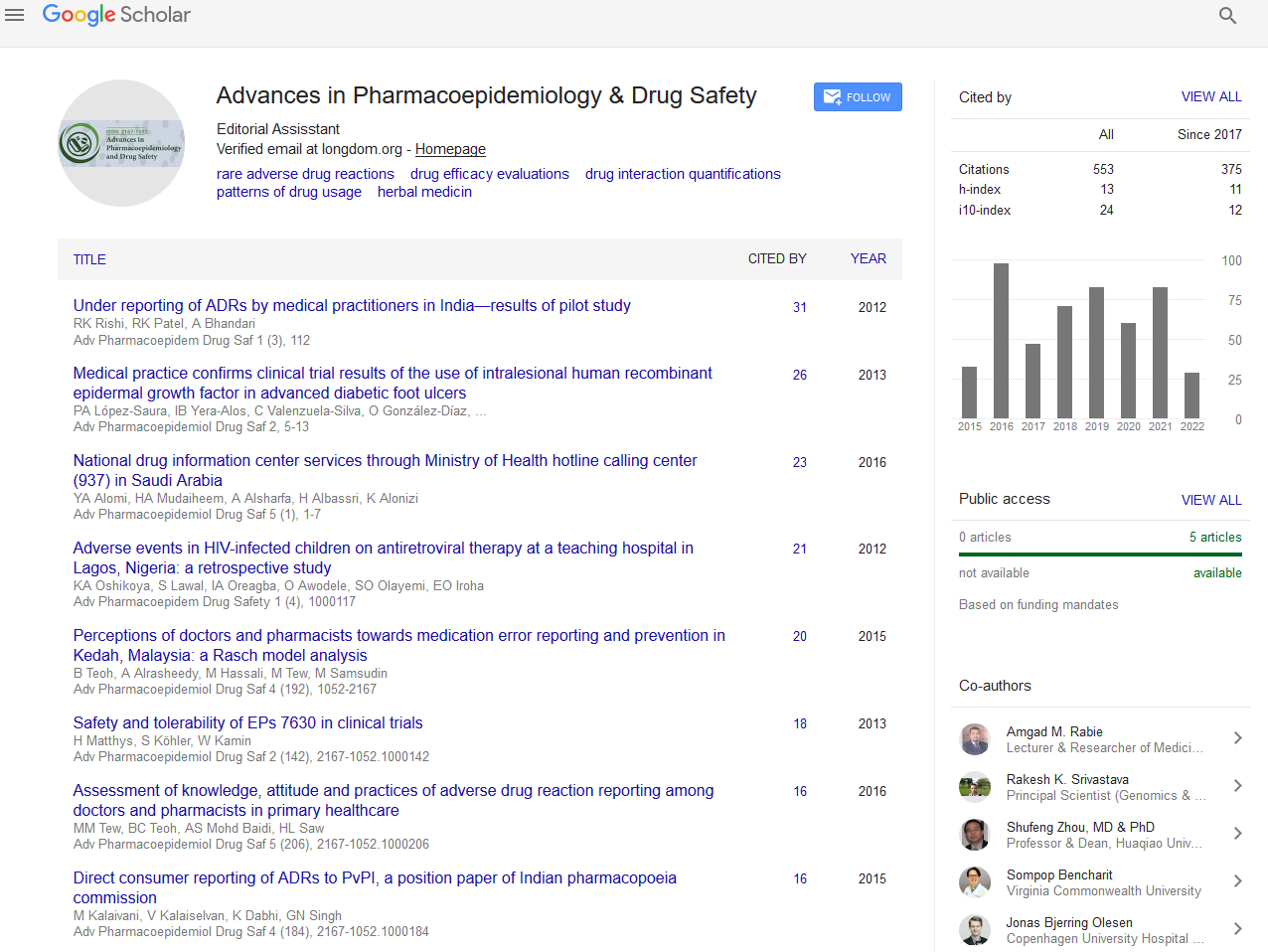Indexed In
- Open J Gate
- Genamics JournalSeek
- Academic Keys
- JournalTOCs
- RefSeek
- Hamdard University
- EBSCO A-Z
- SWB online catalog
- Publons
- Geneva Foundation for Medical Education and Research
- Euro Pub
- Google Scholar
Useful Links
Share This Page
Journal Flyer

Open Access Journals
- Agri and Aquaculture
- Biochemistry
- Bioinformatics & Systems Biology
- Business & Management
- Chemistry
- Clinical Sciences
- Engineering
- Food & Nutrition
- General Science
- Genetics & Molecular Biology
- Immunology & Microbiology
- Medical Sciences
- Neuroscience & Psychology
- Nursing & Health Care
- Pharmaceutical Sciences
Preparation, optimization and evaluation of mucoadhesive microspreres of Stavudine
11th International Conference on Pharmacoepidemiology and Clinical Research
October 02-03, 2017 Kuala Lumpur, Malaysia
Lalwani S
Metro College of Health Sciences & Research, India
Scientific Tracks Abstracts: Adv Pharmacoepidemiol Drug Saf
Abstract:
Drug delivery systems (DDS) that can precisely control the release rate or target drug(s) to a specific body site had an enormous impact on the health care system. Microspheres constitute an important part of these particulate DDS by virtue of their small size and efficient carrier characteristics. However, the success of these novel DDS is limited due to their short residence time at the site of absorption. It would, therefore, be advantageous to have means for providing an intimate contact of the DDS with absorbing membranes. It can be achieved by coupling mucoadhesion characteristics to microspheres and developing novel delivery systems as mucoadhesive microspheres. Stavudine, a nucleoside analogue of thymidine is used in the treatment of HIV. Stavudine has short half-life of 2.3 hours thereby requiring twice daily in large number of patients which leads to no patient compliance. Dosage forms that are retained in the stomach would increase the absorption, improve drug efficiency and decrease dose requirements. In the present study keeping an objective of dosage forms that are retained in the stomach, mucoadhesive microspheres of Stavudine were prepared by orifice-gelation method using as a coat, chitosan and natural mucoadhesive polymers i.e., black gram lentils. Thus the development of mucoadhesive microspheres for controlled release would be advantageous. The mucoadhesive microspheres of Stavudine were conveniently prepared by orifice ionic gelation method using sodium alginate mucoadhesive polymers (synthetic/natural) and mucilage isolated from the black gram lentils. The mucoadhesive microspheres were prepared in 1:1, 1:2 and 1:3 cores: coat (coat composition was rate controlling polymer: mucoadhesive polymer at 1:1 weight ration). The polymer chitosan was selected to control the release rate as synthetic and chitosan, mucilages isolated from black gram lentils, were selected as natural mucoadhesive polymer. In first set three formulations viz., AF-1, AF-2 and AF-3 were formulated with chitosan and three formulations viz., AF-4, AF-5 and AF-6 formulated with black gram lentils. All the prepared mucoadhesive microspheres were subjected for characterization. The production yields were in the range of 84.51±0.38 to 95.56±0.31 and the percentage drug content were in the range of 95.21±0.45 to 99.12±0.45 with low SD and CV value indicating uniform distribution of drug within the various batches of microspheres prepared with negligible loss during the formulation stage. The percentage encapsulation efficiency was in the range of 95.21±0.45 to 99.12±0.45 and increased progressively with increase in the concentration of sodium alginate. The microspheres were distributed in the range of 928.95 μm to 932.071 μm. The microspheres exhibited excellent mucoadhesive property and good drug entrapment. Formulations showed polymer concentration dependent drug release over a period of 12 hours. Microspheres were having good mucoadhesive property with good encapsulation capacity and a sustained release property. Formulations showed polymer concentration dependent drug release over a period of 12 hours. Microspheres were having good mucoadhesive property with good encapsulation capacity and a sustained release property.
Biography :
Surendra Lalwani has completed his PhD, MPharm, BPharm and PGDMM from Dr. H. S. Gour Central University, India. He has more than 18 years of teaching and research experience with keen interest and expertise of research in photodynamic therapy. He is presently working as Principal, Metro College of Health Sciences and Research, Metro College of Pharmacy, India. He is the Member of Indian Association for Cancer Research, The Association of Pharmaceutical Teachers of India, Indian Science Congress Association, Indian Chemistry Teachers Association and International Society for Infectious Disease. He is also an Editorial Board Member of Asian Journal of Pharmaceutical Analysis and Medicinal Chemistry.


